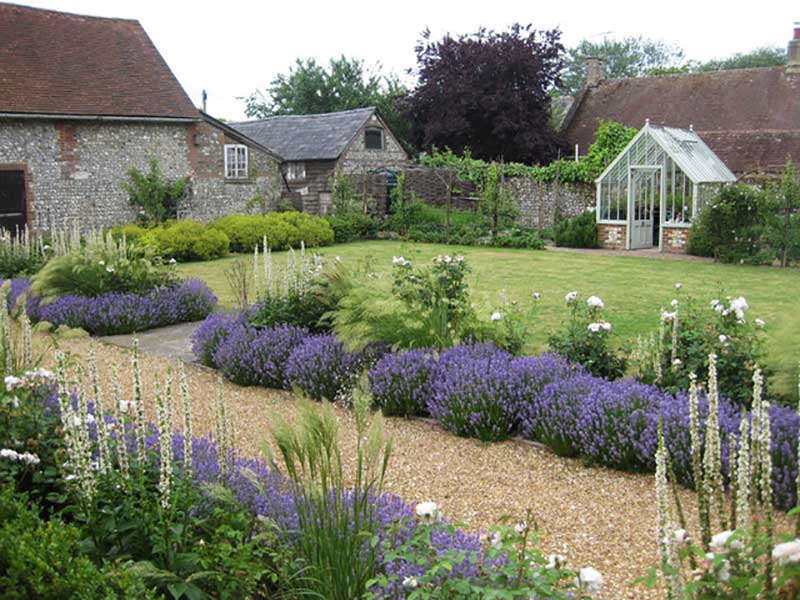Green space design using lavender
Lavandula stoechas L is a plant of the family Nanasan that leaves and the green part of the plant has volatile oily essential oils. Lavender is a perennical plant in the form of a small plant as tall as half a meter very high, its stems quadrangle, its leaves elongated, reciprocal, covered with white cotton crack.
In recent years, one of the most widely used plants in landscape design has been in urban parks and hedges and lavender green walls.
Lavandula stoechas L is a plant of the family Nanasan that leaves and the green part of the plant has volatile oily essential oils. Lavender is a perennical plant in the form of a small plant as tall as half a meter very high, its stems quadrangle, its leaves elongated, reciprocal, covered with white cotton crack. Its flowers that appear in spring are in dark purple as spikes. Lavender has fragrant leaves and cracks.The fruit of this plant is four hazelnuts and each of them, after ripening, finds elliptical shape and clear brown color. On the fruit surface, three distinct appendages are found. From all parts of this plant, especially its leafy branches, it smells pungent and pleasant. The beautiful appearance of the plant after flowering causes it to be cultivated as an ornamental plant in some areas. The used part of this plant is its leafy and flowering branches, which in addition to therapeutic uses, are used in essential oils.
The chemical composition of lavender essential oil is composed of a type of substance (with the smell of kamfer and mint) cineol, alcohol and linalool.
The French lavender vegetative period is very long and usually lasts 20 to 30 years and has economic returns of up to 15 to 20 years.
Lavender is one of the plants of arid and semi-arid regions. During the genesis, it requires abundant light and warm air and low humidity.
Its proliferation is done by taking cuttings in spring or autumn in the chassis using twigs whose wood is semi-rusty. In addition, it is possible by seed cultivation in spring and in sandy soils and in chassis.
Application: Lavender application in green spaces is common as a rocky garden plant or hedge plant, while it is used in regular and irregular designs and volume-building schemes. Because its potential is good compared to the ness, it can also be used for conversion and forming.
For medicinal purposes, the flowering stems are picked lavender and after the flowers are dried on the stem, they are collected and consumed. Lavender is also a mild analgesic and its essential oil is used in anti-rheumatic compounds.
Lavender essential oil is the most used in the health and cosmetic industries. This plant has a good aroma and therefore is one of the main constituents of cologne. Dried flowers use it to make clothes fragrant and run away willows. Lavender honey is a very good donor and has a high profit in beekeeping centers, lavender flowering period in August and lavender harvesting time from stems and flowers is also in July and August.
Although lavender is able to withstand low temperatures (-15-20°C), it is very sensitive to cold during plant growing and foliage production, and with the occurrence of cold, plants become frostbite and dry. Therefore, the cultivation of this plant in the pit lands and cold areas should be avoided as much as possible.
It is necessary to add appropriate amounts of nutrients and nutrients to the fields where lavender is cultivated each year. The amount of these materials varies depending on climatic conditions and soil type.
Researches show that after the first harvest, the use of nitrogen fertilizers and the application of nutrient solutions is not suitable and reduces the resistance of plants to winter cold.
Soil Preparation
Since lavender remains in the same area for 15 to 20 years, all plant food needs must be provided by the soil in which it is cultivated. Therefore, a year before cultivation, the land must be prepared.
Therapeutic properties and applications
The essential oil of this plant has properties such as strong antibacterial, sedative and effective in the treatment of rheumatism. French lavender essential oil is obtained from distillation of flowering twigs with water vapor. If this is done at the harvest site, it will yield more. The leaves and flowers of this plant have coumarin, flavonoids, sterols and tannins.

